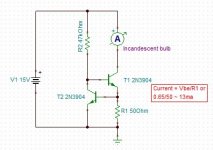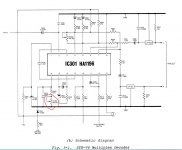What service info that seems to be available does not specify anything about the stereo indicator bulb. How about opening it up and see if you can read a number on the bulb?
About 100 ohms cold, 1k hot, infinity when burned-out.
Note that there is also a 270r and maybe a 15k in that circuit.
(It is a 12V bulb but is run from a 15V supply with 270r series and probably not run at max voltage. 12mA in 270r is 3.24V drop, plus a tenth inside the chip, is about 11.5V on the lamp. Hot resistance 11.5V/12mA is 1k near-enough. Colt resistance tends to be 1/10th of hot resistance, so 100r. Burned-out resistance is infinity, near-enough.)
Note that there is also a 270r and maybe a 15k in that circuit.
(It is a 12V bulb but is run from a 15V supply with 270r series and probably not run at max voltage. 12mA in 270r is 3.24V drop, plus a tenth inside the chip, is about 11.5V on the lamp. Hot resistance 11.5V/12mA is 1k near-enough. Colt resistance tends to be 1/10th of hot resistance, so 100r. Burned-out resistance is infinity, near-enough.)
Last edited:
Could be an 8 volt 30 mA bulb too. That would be 270 ohms hot, about 27 ohms cold and infinite if burned out. Curious why the OP want to know the bulb resistance.
It's about the only thing you can test with a multimeter alone, if you're inexperienced and just want to replace some dead bulbs. It's probably only relevant to close equivalents with the same power ratings but your options for checking what's available in a store are likely limited to that and salespersons don't know much about their stock, even if the data is right there in a catalog.
Last edited:
Thanks for the replies. No stereo separation in fm. Vinyl yes. Tiny bulb looks good, hence the question.
Constant current sink.
A better way to supply current to an incandescent bulb is to use a constant current circuit. I've used the following with good success for other dynamic loads as well with great success. Two small signal NPN transistors and two resistors make a constant current sink. The benefit is the turn on surge is cancelled when the bulb is cold. This goes a long way to increasing bulb life. A video of an incandescent filament at turn on illustrates just how violent the filament movement is during the surge.
Another benefit is regulation - to a degree it won't matter what the supply voltage is as long as it is greater than what is needed as called for by the bulb spec.
One can easily attach a switch to the base of the top transistor to GND to have an on/off control or use an open collector computer port, etc if that is desired.
A better way to supply current to an incandescent bulb is to use a constant current circuit. I've used the following with good success for other dynamic loads as well with great success. Two small signal NPN transistors and two resistors make a constant current sink. The benefit is the turn on surge is cancelled when the bulb is cold. This goes a long way to increasing bulb life. A video of an incandescent filament at turn on illustrates just how violent the filament movement is during the surge.
Another benefit is regulation - to a degree it won't matter what the supply voltage is as long as it is greater than what is needed as called for by the bulb spec.
One can easily attach a switch to the base of the top transistor to GND to have an on/off control or use an open collector computer port, etc if that is desired.
Attachments
Only service info I can find, this is from the V2/V3/V4 manual. Note the current position of RT301. While tuned to a know stereo station, adjust it through its range and see if you can get the stereo light to come on. If not, return it to its original position.Thanks for the replies. No stereo separation in fm. Vinyl yes. Tiny bulb looks good, hence the question.
Attachments
- Home
- Amplifiers
- Solid State
- Bulb resistance

